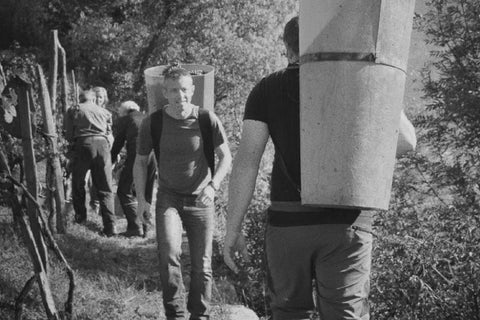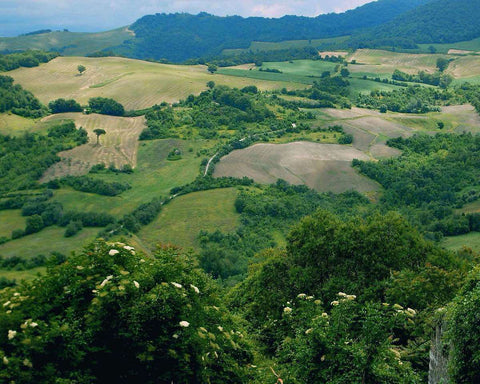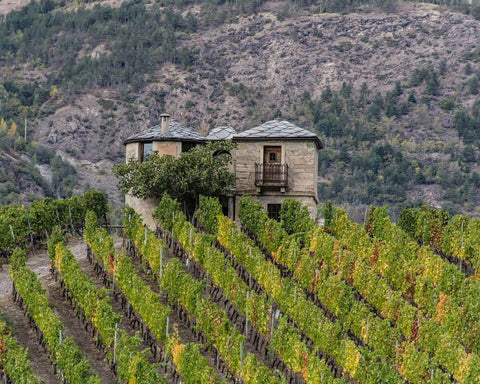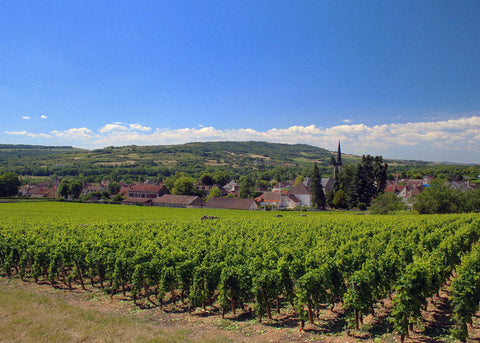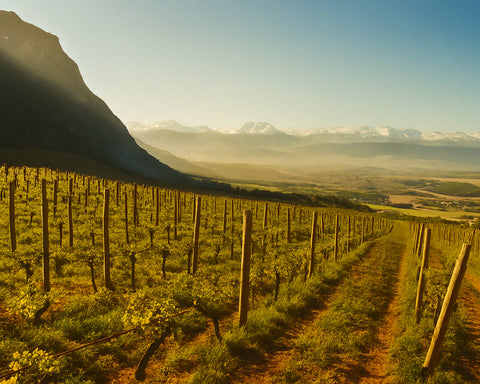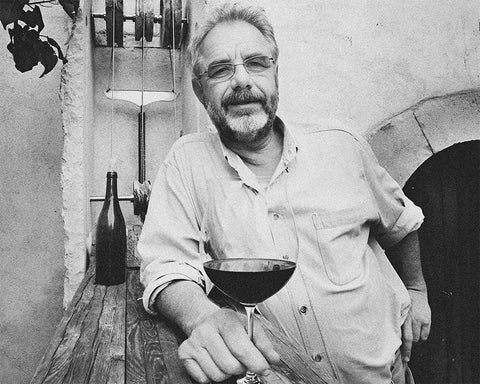The Marche region, often called the "gateway to the east," is one of Italy's most diverse and culturally rich areas. Nestled between the Adriatic Sea and the Apennine Mountains, this central Italian gem is renowned for its picturesque landscapes, historic towns, and a tradition of winemaking that stretches back centuries.
Over the years, Marche has emerged as a stronghold for sustainable and organic agriculture, focusing on preserving its natural beauty and agricultural heritage. The region's dedication to maintaining a balance between innovation and tradition is evident in its thriving viticulture and gastronomy.
The wines from Marche are not just beverages; they reflect the region's complex history, commitment to excellence, and deep-rooted passion for the land. This is especially true for its famous Verdicchio and Rosso Conero wines, which encapsulate the essence of Marche.
Table of Contents
History of Marche
The Marche region has a rich and varied history from prehistoric times. The region has been inhabited by various cultures, including the Picenes, Etruscans, Greeks, and Romans, each significantly impacting the local culture and landscape.
During the Roman era, Marche became an important center for trade and military operations, thanks to its strategic location and network of roads, including the famous Via Flaminia.
In the Middle Ages, Marche was a collection of independent city-states and principalities. The influence of the Church was strong, with many towns like Loreto becoming important religious centers. The region also flourished artistically and culturally during the Renaissance, producing notable figures such as Raphael and Gioachino Rossini.
The unification of Italy in the 19th century brought significant changes to Marche, integrating it more closely with the rest of the country. However, the region has managed to retain its distinct identity and continues to be a bastion of traditional Italian culture and lifestyle.
Terroir of Marche
The terroir of Marche is characterized by its diverse landscape, which includes rolling hills, fertile plains, and a long coastline along the Adriatic Sea. The region enjoys a Mediterranean climate with continental influences, providing ideal conditions for various agricultural products.
The Apennine Mountains protect the region from extreme weather, creating a variety of microclimates that are perfect for viticulture. The soils in Marche are equally varied, ranging from limestone and clay in the inland areas to sandy and alluvial soils along the coast.
This diversity in terrain and climate allows Marche to produce a wide array of high-quality wines, each reflecting the unique characteristics of their growing environment.
The Geology of Marche
The Marche landscape predominantly comprises hilly terrain, with elevations ranging from sea level to over 1,500 meters in the Apennines. The region is divided into several sub-regions, each with distinct geological features that influence the wines' character.
- Colli Pesaresi: Known for its clay and limestone soils, this area is ideal for growing Sangiovese and other red grape varieties.
- Castelli di Jesi: Famous for its Verdicchio vineyards, this area features calcareous marl soils that provide excellent drainage.
- Conero: The limestone-rich soils of the Conero peninsula are perfect for Montepulciano, producing robust and full-bodied wines.
The geological diversity of Marche ensures that each wine expresses the unique characteristics of its terroir, enhancing the complexity and depth of the region's wines.
Climate and Its Influence
Marche's climate is predominantly Mediterranean, with hot summers and mild winters. The region benefits from significant diurnal temperature variation, especially in the hilly and mountainous areas, which is crucial for developing grape sugars and acids.
The coastal areas experience more moderate temperatures, influenced by the Adriatic Sea, while the inland regions see more pronounced seasonal changes. This climatic diversity contributes to the distinctiveness of Marche's wines and agricultural products.
The Grapes of Marche
Marche boasts several indigenous grape varieties, each adapted to the region's unique terroir. The most notable are Verdicchio, Montepulciano, and Sangiovese.
White Grape Varietals
- Verdicchio: The cornerstone of Marche's most celebrated white wines, known for its crisp acidity and green apple flavors.
- Pecorino: Produces aromatic and full-bodied white wines with good acidity.
- Passerina: A versatile grape that can produce both dry and sweet wines, known for its floral and citrus notes.
- Bianchello: Adds freshness and fruitiness to white blends.
Red Grape Varietals
- Montepulciano: The primary grape in Rosso Conero and Rosso Piceno, known for its deep color and rich flavors of dark fruit and spice.
- Sangiovese: Widely planted and used in various blends, known for its high acidity and bright cherry flavors.
- Lacrima: Produces aromatic and floral red wines, primarily in the Lacrima di Morro d'Alba DOC.
- Aleatico: Used for both dry and sweet red wines, known for its intense aromatics.
Top Wines of Marche
Verdicchio dei Castelli di Jesi: Often considered the flagship wine of Marche, Verdicchio dei Castelli di Jesi is known for its crisp acidity, floral aromas, and flavors of green apple and almond. It can be enjoyed young or aged for added complexity.
Rosso Conero: A robust red wine made primarily from Montepulciano grapes, Rosso Conero is celebrated for its deep color, rich fruit flavors, and well-structured tannins. It is an excellent wine for aging.
Other Notable Wines: Marche is also home to a variety of other notable wines, including Rosso Piceno, made from a blend of Sangiovese and Montepulciano, and Lacrima di Morro d'Alba, known for its aromatic intensity and floral notes. The region's diverse terroir allows for a wide range of wine styles, each offering a unique expression of Marche's character.
Cuisine and Typical Products of Marche
Marche's culinary landscape is as rich and diverse as its history. The region is known for its hearty and flavorful dishes, strongly emphasizing local and seasonal ingredients. Marche's cuisine reflects the influences of its varied past, from Roman and Byzantine to Renaissance, creating a unique and vibrant culinary tradition.
Using wild herbs, fresh vegetables, and high-quality meats is a hallmark of Marchigiana cuisine. Other staples include olive oil, truffles, and seafood, reflecting the region's agricultural abundance and coastal access.
Marche is also famous for its cured meats and cheeses, integral to the local diet and culinary identity. From the delicate Ciauscolo sausage to the tangy Pecorino cheese, these products showcase the region's dedication to artisanal food production.
Marchigiana Antipasti
In Marche, a meal often begins with a selection of antipasti, featuring local cheeses, cured meats, and marinated vegetables. These appetizers set the stage for the hearty courses to follow.
- Ciauscolo: A spreadable sausage made from pork and seasoned with garlic and pepper, often served on bread.
- Olive all'ascolana: Stuffed and fried olives, filled with a mixture of meat and herbs, a quintessential Marchigiana appetizer.
- Verdure sott'olio: Marinated vegetables preserved in olive oil, garlic, and herbs, a classic antipasto.
- Crostini ai fegatini: Chicken liver crostini, highlighting the rustic flavors of Marche.
Marchigiana Primi Piatti (First Courses)
The first course in a Marchigiana meal often features pasta, risotto, or hearty soups. These dishes showcase the region's grains, legumes, and seasonal vegetables.
- Vincisgrassi: A traditional lasagna from Marche, layered with ragù, béchamel, and Parmigiano-Reggiano.
- Brodetto: A rich fish stew made with various seafood, tomatoes, and white wine, typical of the coastal areas.
- Pasta con i ceci: Pasta with chickpeas, seasoned with rosemary and garlic, a rustic and satisfying dish.
- Risotto alla marinara: Seafood risotto, reflecting the coastal influence on Marchigiana cuisine.
Marchigiana Secondi (Second Courses)
Marche is known for its high-quality meats, particularly pork and lamb. The second course often features these prized ingredients, prepared with local herbs and spices.
- Coniglio in porchetta: Rabbit roasted with fennel, garlic, and herbs, a flavorful and aromatic dish.
- Maialino al forno: Oven-roasted suckling pig, seasoned with rosemary and garlic.
- Stoccafisso all'anconetana: Salt cod cooked with tomatoes, potatoes, and olives, a traditional dish from Ancona.
- Pollo alla cacciatora: Chicken cooked with tomatoes, olives, and white wine, a hearty and rustic dish.
Marchigiana Contorni (Side Dishes)
Marchigiana cuisine features an array of vegetable side dishes, highlighting the region's agricultural bounty.
- Patate arrosto: Roasted potatoes with rosemary and garlic, a simple yet flavorful accompaniment.
- Zucchine trifolate: Sautéed zucchini with garlic and parsley, a light and fresh side dish.
- Insalata di campo: A salad made with wild greens, dressed with olive oil and lemon.
Marchigiana Formaggi (Cheeses)
Marche produces some of Italy's most distinctive cheeses, often enjoyed as part of a cheese course or used in cooking.
- Pecorino dei Monti Sibillini: A sheep's milk cheese with a robust flavor, often aged to develop a rich and intense taste.
- Formaggio di fossa: A cheese aged in underground pits, resulting in a unique flavor and texture.
- Casciotta d'Urbino: A soft cheese made from a mix of sheep's and cow's milk, known for its creamy texture and delicate flavor.
- Caciotta: A semi-soft cheese with a mild flavor, often enjoyed with bread and honey.
Marchigiana Dolci (Desserts)
Marchigiana desserts often feature local ingredients such as almonds, honey, and seasonal fruits.
- Crostata di visciole: A tart made with sour cherries, a traditional dessert from the Marche region.
- Cicerchiata: A festive dessert made of fried dough balls coated in honey and decorated with colorful sprinkles.
- Frustingo: A dense fruitcake made with dried fruits, nuts, and honey, typically enjoyed during the holidays.
- Crema fritta: Fried custard squares, crispy on the outside and creamy on the inside.
Typical Products of Marche
Marche's cuisine is based on high-quality local products, many of which have achieved protected status, ensuring authenticity and traditional production methods.
Olive Oil
The Marche region is renowned for its high-quality olive oil, particularly from the Ascolana Tenera olive variety. The oil is known for its delicate flavor and is a staple in Marchigiana cooking.
Truffles
Marche is a significant producer of truffles, particularly the prized white truffles from Acqualagna. These truffles are a key ingredient in many traditional dishes and are celebrated for their aromatic intensity.
Cheese
Marche produces a wide variety of cheeses, each reflecting the characteristics of its production area.
- Pecorino di Farindola: A sheep's milk cheese with a strong, tangy flavor, often aged to enhance its intensity.
- Formaggio di fossa: A cheese aged in underground pits, resulting in a unique flavor and texture.
- Casciotta d'Urbino: A soft cheese made from a mix of sheep's and cow's milk, known for its creamy texture and delicate flavor.
Meat and Charcuterie
Marche's meat products are known for their quality and distinctive flavors.
- Ciauscolo: A spreadable sausage made from pork and seasoned with garlic and pepper, often served on bread.
- Soppressata: A dry-cured salami made from pork, seasoned with chili peppers and other spices.
- Prosciutto di Carpegna DOP: A dry-cured ham with a delicate flavor produced in the Carpegna area.
Fruits and Vegetables
Marche's varied climate allows cultivating a wide range of produce.
- Olive Ascolane: Large green olives from Ascoli Piceno, often stuffed and fried for the famous Olive all'ascolana.
- Verdicchio grapes: Used primarily for winemaking, these grapes are also enjoyed fresh or dried.
- Black truffles: Found in the woods of Marche, these truffles are used in many traditional dishes.


